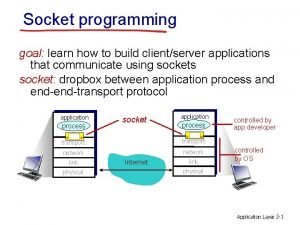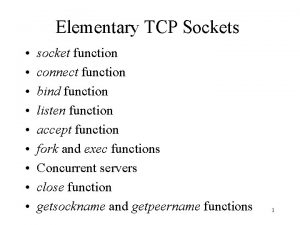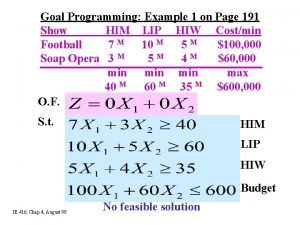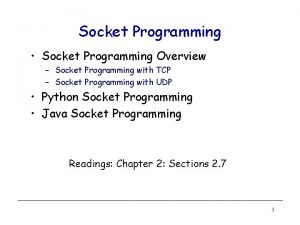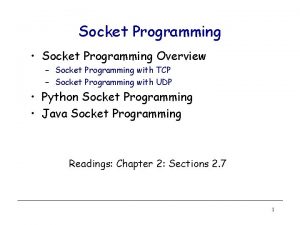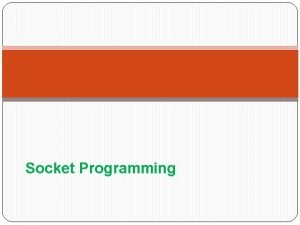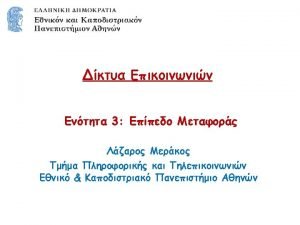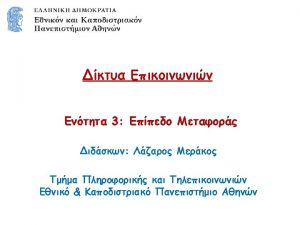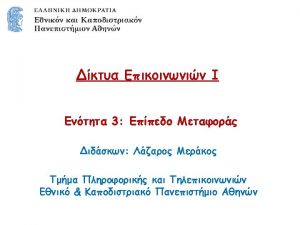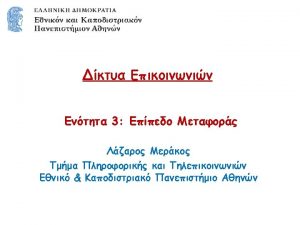Socket programming in C 1 Socket programming Goal







![Example: C client (TCP) /* client. c */ void main(int argc, char *argv[]) { Example: C client (TCP) /* client. c */ void main(int argc, char *argv[]) {](https://slidetodoc.com/presentation_image_h2/a3abf338d53d061f6472e33859cc65f6/image-8.jpg)

![Example: C server (TCP) /* server. c */ void main(int argc, char *argv[]) { Example: C server (TCP) /* server. c */ void main(int argc, char *argv[]) {](https://slidetodoc.com/presentation_image_h2/a3abf338d53d061f6472e33859cc65f6/image-10.jpg)




![Example: C client (UDP) /* client. c */ void main(int argc, char *argv[]) { Example: C client (UDP) /* client. c */ void main(int argc, char *argv[]) {](https://slidetodoc.com/presentation_image_h2/a3abf338d53d061f6472e33859cc65f6/image-15.jpg)

![Example: C server (UDP) /* server. c */ void main(int argc, char *argv[]) { Example: C server (UDP) /* server. c */ void main(int argc, char *argv[]) {](https://slidetodoc.com/presentation_image_h2/a3abf338d53d061f6472e33859cc65f6/image-17.jpg)



- Slides: 20

Socket programming in C 1

Socket programming Goal: learn how to build client/server application that communicate using sockets Socket API • introduced in BSD 4. 1 UNIX, 1981 • explicitly created, used, released by apps • client/server paradigm • two types of transport service via socket API: – unreliable datagram – reliable, byte stream-oriented socket a host-local, application-created, OS-controlled interface (a “door”) into which application process can both send and receive messages to/from another application process 2

Socket-programming using TCP Socket: a door between application process and endend-transport protocol (UDP or TCP) TCP service: reliable transfer of bytes from one process to another controlled by application developer controlled by operating system process socket TCP with buffers, variables host or server internet socket TCP with buffers, variables controlled by application developer controlled by operating system host or server 3

Socket programming with TCP Client must contact server • • server process must first be running • server must have created socket (door) that welcomes client’s contact When contacted by client, server TCP creates new socket for server process to communicate with client – allows server to talk with multiple clients – source port numbers used to distinguish clients (more in Chap 3) Client contacts server by: • creating client-local TCP socket • specifying IP address, port number of server process application viewpoint • When client creates socket: TCP provides reliable, in-order client TCP establishes transfer of bytes (“pipe”) between client and server connection to server TCP 4

Stream jargon • A stream is a sequence of characters that flow into or out of a process. • An input stream is attached to some input source for the process, eg, keyboard or socket. • An output stream is attached to an output source, eg, monitor or socket. 5

Socket programming with TCP Example client-server app: 1) client reads line from standard input (in. From. User stream) , sends to server via socket (out. To. Server stream) 2) server reads line from socket 3) server converts line to uppercase, sends back to client 4) client reads, prints modified line from socket (in. From. Server stream) Client process client TCP socket 6

Client/server socket interaction: TCP Server (running on hostid, port x) Client create socket, port=x, for incoming request: welcome. Socket = Server. Socket() TCP wait for incoming connection request connection. Socket = welcome. Socket. accept() read request from connection. Socket write reply to connection. Socket close connection. Socket setup create socket, connect to hostid, port=x client. Socket = Socket() write request using client. Socket read reply from client. Socket close client. Socket 7
![Example C client TCP client c void mainint argc char argv Example: C client (TCP) /* client. c */ void main(int argc, char *argv[]) {](https://slidetodoc.com/presentation_image_h2/a3abf338d53d061f6472e33859cc65f6/image-8.jpg)
Example: C client (TCP) /* client. c */ void main(int argc, char *argv[]) { struct sockaddr_in sad; /* structure to hold an IP address */ int client. Socket; /* socket descriptor */ struct hostent *ptrh; /* pointer to a host table entry */ char Sentence[128]; char modified. Sentence[128]; Create client socket, connect to server host = argv[1]; port = atoi(argv[2]); client. Socket = socket(PF_INET, SOCK_STREAM, 0); memset((char *)&sad, 0, sizeof(sad)); /* clear sockaddr structure */ sad. sin_family = AF_INET; /* set family to Internet */ sad. sin_port = htons((u_short)port); ptrh = gethostbyname(host); /* Convert host name to IP address */ memcpy(&sad. sin_addr, ptrh->h_length); connect(client. Socket, (struct sockaddr *)&sad, sizeof(sad)); 8

Example: C client (TCP), cont. Get input stream from user Send line to server Read line from server gets(Sentence); n=write(client. Socket, Sentence, strlen(Sentence)+1); n=read(client. Socket, modified. Sentence, sizeof(modified. Sentence)); printf("FROM SERVER: %sn”, modified. Sentence); Close connection close(client. Socket); } 9
![Example C server TCP server c void mainint argc char argv Example: C server (TCP) /* server. c */ void main(int argc, char *argv[]) {](https://slidetodoc.com/presentation_image_h2/a3abf338d53d061f6472e33859cc65f6/image-10.jpg)
Example: C server (TCP) /* server. c */ void main(int argc, char *argv[]) { struct sockaddr_in sad; /* structure to hold an IP address */ struct sockaddr_in cad; int welcome. Socket, connection. Socket; /* socket descriptor */ struct hostent *ptrh; /* pointer to a host table entry */ char client. Sentence[128]; char capitalized. Sentence[128]; Create welcoming socket at port & Bind a local address port = atoi(argv[1]); welcome. Socket = socket(PF_INET, SOCK_STREAM, 0); memset((char *)&sad, 0, sizeof(sad)); /* clear sockaddr structure */ sad. sin_family = AF_INET; /* set family to Internet */ sad. sin_addr. s_addr = INADDR_ANY; /* set the local IP address */ sad. sin_port = htons((u_short)port); /* set the port number */ bind(welcome. Socket, (struct sockaddr *)&sad, sizeof(sad)); 10

Example: C server (TCP), cont /* Specify the maximum number of clients that can be queued */ listen(welcome. Socket, 10) Wait, on welcoming socket for contact by a client while(1) { connection. Socket=accept(welcome. Socket, (struct sockaddr *)&cad, &alen); n=read(connection. Socket, client. Sentence, sizeof(client. Sentence)); /* capitalize Sentence and store the result in capitalized. Sentence*/ n=write(connection. Socket, capitalized. Sentence, strlen(capitalized. Sentence)+1); close(connection. Socket); } Write out the result to socket } End of while loop, loop back and wait for another client connection 11

Socket programming with UDP: no “connection” between client and server • no handshaking • sender explicitly attaches IP address and port of destination to each packet • server must extract IP address, port of sender from received packet UDP: transmitted data may be received out of order, or lost application viewpoint UDP provides unreliable transfer of groups of bytes (“datagrams”) between client and server 12

Client/server socket interaction: UDP Server (running on hostid, port x) create socket, port=x, for incoming request: server. Socket = Datagram. Socket() read request from server. Socket write reply to server. Socket specifying client host address, port number Client create socket, client. Socket = Datagram. Socket() Create, address (hostid, port=x, send datagram request using client. Socket read reply from client. Socket close client. Socket 13

Example: Java client (UDP) Client process Input: receives packet (TCP received “byte stream”) Output: sends packet (TCP sent “byte stream”) client UDP socket 14
![Example C client UDP client c void mainint argc char argv Example: C client (UDP) /* client. c */ void main(int argc, char *argv[]) {](https://slidetodoc.com/presentation_image_h2/a3abf338d53d061f6472e33859cc65f6/image-15.jpg)
Example: C client (UDP) /* client. c */ void main(int argc, char *argv[]) { struct sockaddr_in sad; /* structure to hold an IP address */ int client. Socket; /* socket descriptor */ struct hostent *ptrh; /* pointer to a host table entry */ char Sentence[128]; char modified. Sentence[128]; Create client socket, NO connection to server host = argv[1]; port = atoi(argv[2]); client. Socket = socket(PF_INET, SOCK_DGRAM, 0); /* determine the server's address */ memset((char *)&sad, 0, sizeof(sad)); /* clear sockaddr structure */ sad. sin_family = AF_INET; /* set family to Internet */ sad. sin_port = htons((u_short)port); ptrh = gethostbyname(host); /* Convert host name to IP address */ memcpy(&sad. sin_addr, ptrh->h_length); 15

Example: C client (UDP), cont. Get input stream from user Send line to server Read line from server gets(Sentence); addr_len =sizeof(struct sockaddr); n=sendto(client. Socket, Sentence, strlen(Sentence)+1, (struct sockaddr *) &sad, addr_len); n=recvfrom(client. Socket, modified. Sentence, sizeof(modified. Sentence). (struct sockaddr *) &sad, &addr_len); printf("FROM SERVER: %sn”, modified. Sentence); Close connection close(client. Socket); } 16
![Example C server UDP server c void mainint argc char argv Example: C server (UDP) /* server. c */ void main(int argc, char *argv[]) {](https://slidetodoc.com/presentation_image_h2/a3abf338d53d061f6472e33859cc65f6/image-17.jpg)
Example: C server (UDP) /* server. c */ void main(int argc, char *argv[]) { struct sockaddr_in sad; /* structure to hold an IP address */ struct sockaddr_in cad; int server. Socket; /* socket descriptor */ struct hostent *ptrh; /* pointer to a host table entry */ char client. Sentence[128]; char capitalized. Sentence[128]; Create welcoming socket at port & Bind a local address port = atoi(argv[1]); server. Socket = socket(PF_INET, SOCK_DGRAM, 0); memset((char *)&sad, 0, sizeof(sad)); /* clear sockaddr structure */ sad. sin_family = AF_INET; /* set family to Internet */ sad. sin_addr. s_addr = INADDR_ANY; /* set the local IP address */ sad. sin_port = htons((u_short)port); /* set the port number */ bind(server. Socket, (struct sockaddr *)&sad, sizeof(sad)); 17

Example: C server (UDP), cont Receive messages from clients while(1) { n=recvfrom(server. Socket, client. Sentence, sizeof(client. Sentence), 0 (struct sockaddr *) &cad, &addr_len ); /* capitalize Sentence and store the result in capitalized. Sentence*/ n=sendto(server. Socket, capitalized. Sentence, strlen(capitalized. Sentence)+1, 0 (struct sockaddr *) &cad, &addr_len); Write out the result to socket } } End of while loop, loop back and wait for another client connection 18

Other functions • getpeername( ) • gethostbyaddr( ) if ( (pid=fork()) == 0) { /* CHILD PROC */ close(welcome. Socket); /* give service */ exit(0); • getsockopt( ) } /* PARENT PROC */ • setsockopt ( ) • signal(SIGINT, sigf); close(connection. Socket); 19

Waiting something from socket and stdin FD_ZERO(&rset); FD_SET(welcome. Socket, &rset); FD_SET(fileno(stdin), &rset); maxfd =max(welcome. Socket, fileno(stdin)) + 1; select(maxfd, &rset, NULL, NULL); if (FD_ISSET(fileno(stdin), &rset)){ /* read something from stdin */ } 20
 What is a socket
What is a socket Client in programming
Client in programming Bsd socket interface
Bsd socket interface Bind function in socket programming
Bind function in socket programming R socket programming
R socket programming Socket programming in c
Socket programming in c Gqoute
Gqoute Tcp and udp socket programming in java
Tcp and udp socket programming in java Goal programming excel solver
Goal programming excel solver Goal programming formulation example
Goal programming formulation example Goal programming
Goal programming Goal programming
Goal programming Solving goal programming problems using simplex method
Solving goal programming problems using simplex method Goal programming
Goal programming Integer programming vs linear programming
Integer programming vs linear programming Definisi linear
Definisi linear Greedy vs dynamic programming
Greedy vs dynamic programming Perbedaan linear programming dan integer programming
Perbedaan linear programming dan integer programming System programming
System programming Secure socket layer and transport layer security
Secure socket layer and transport layer security Ball and socket joint
Ball and socket joint

